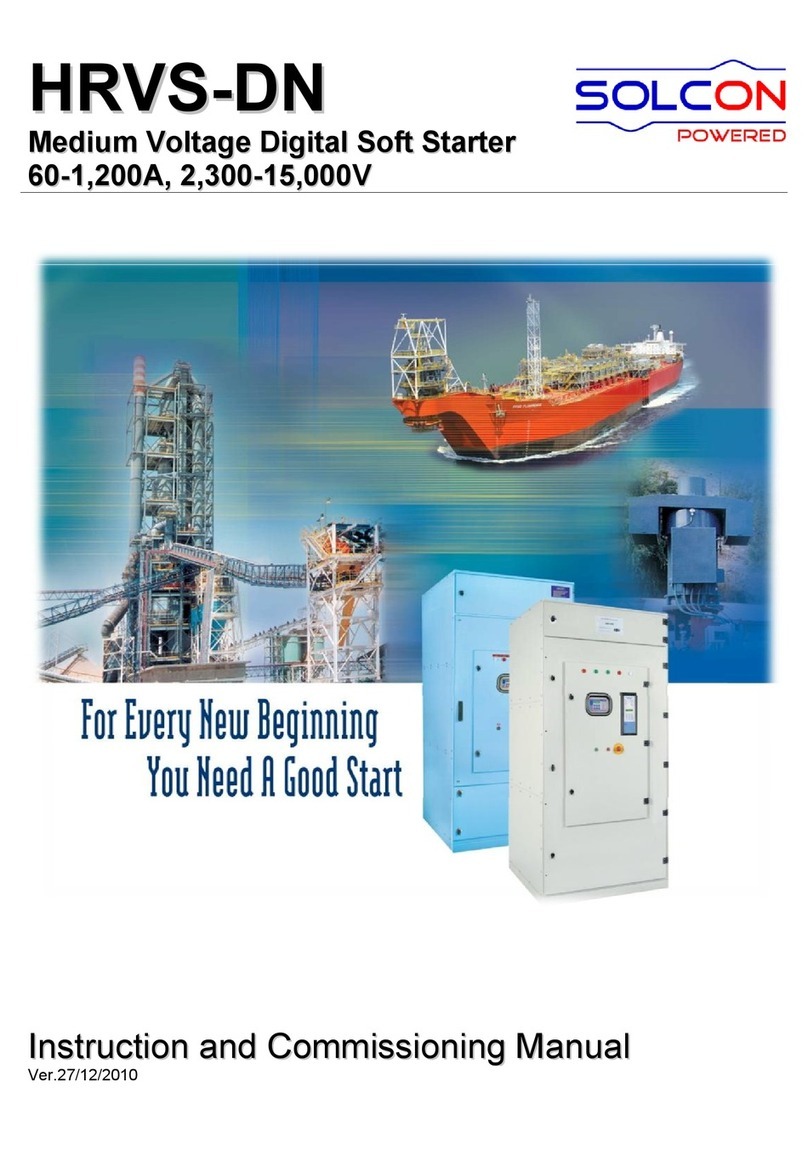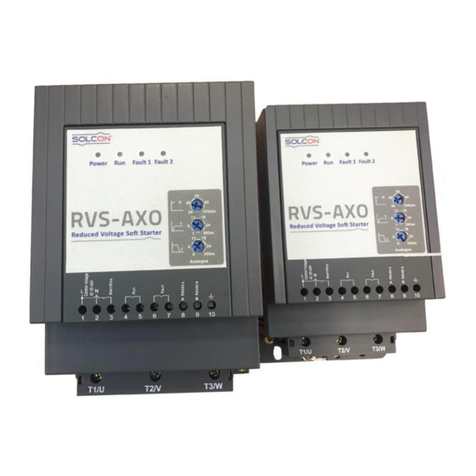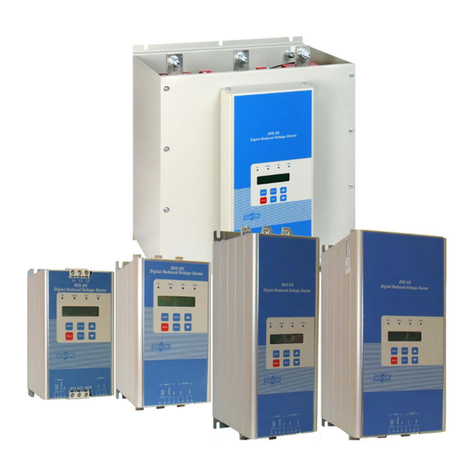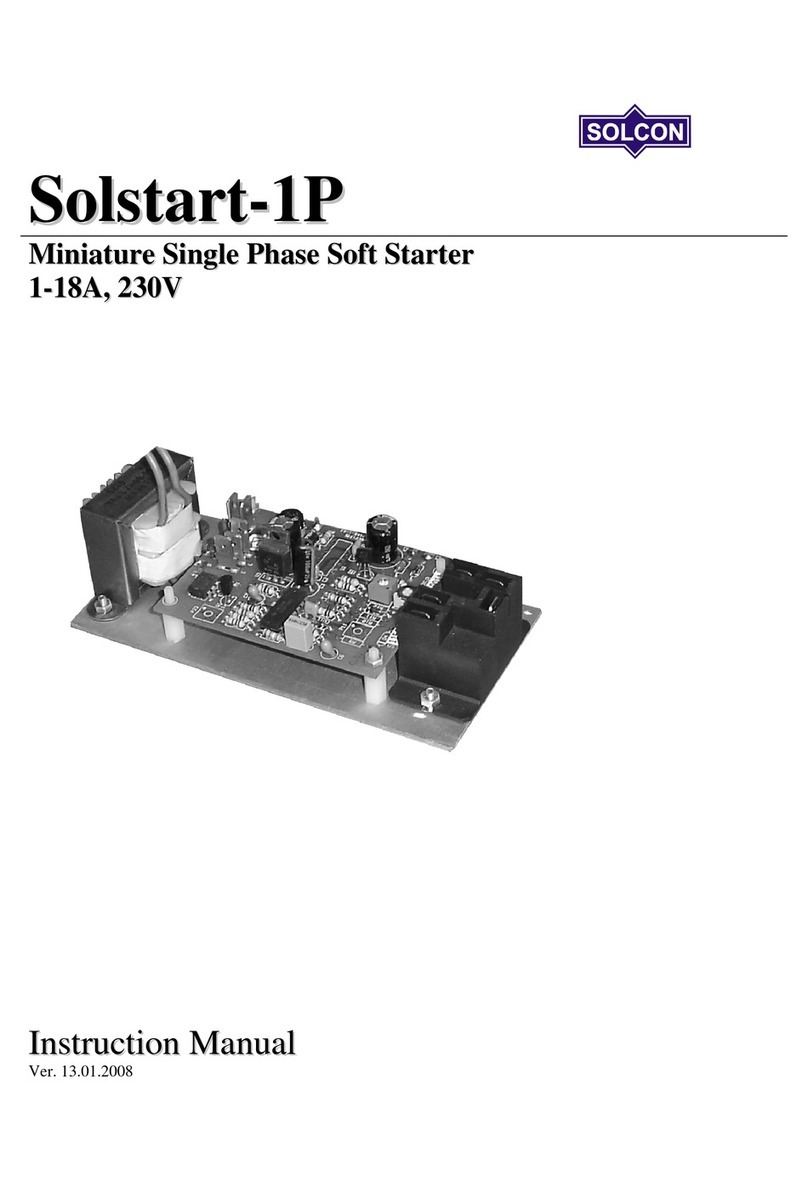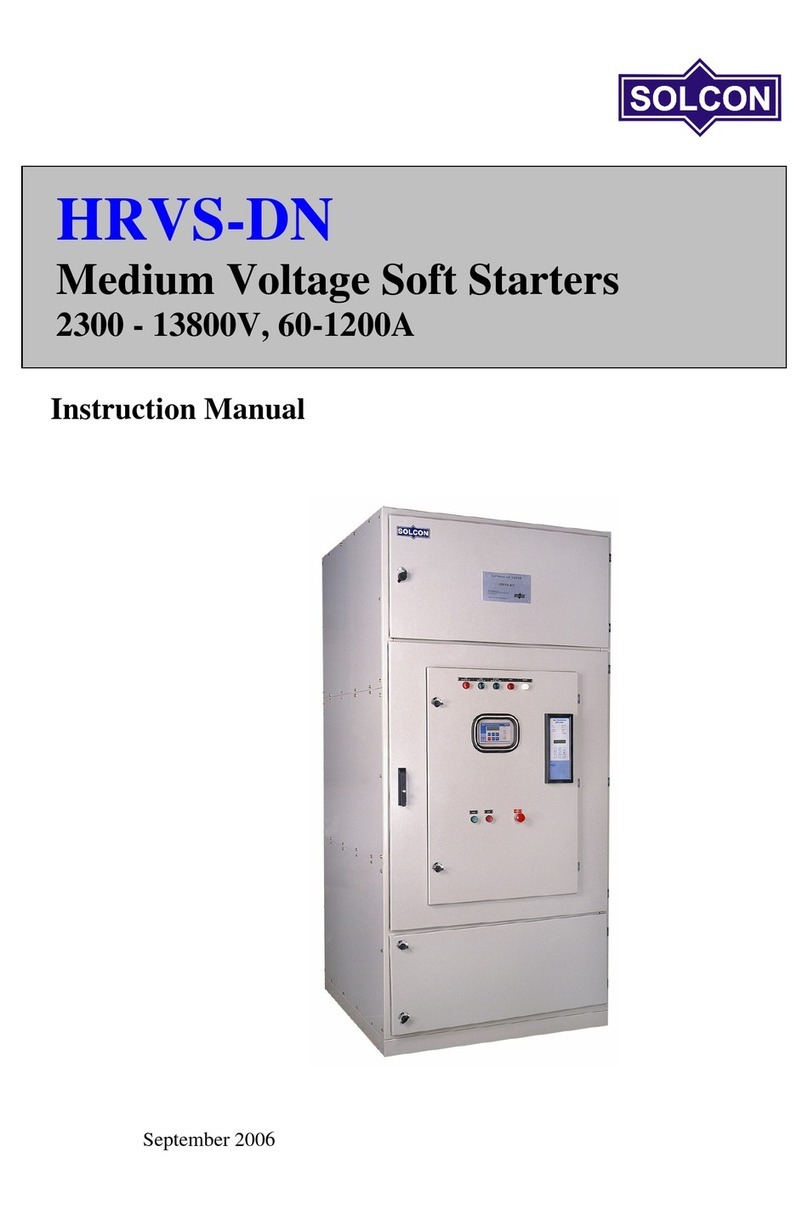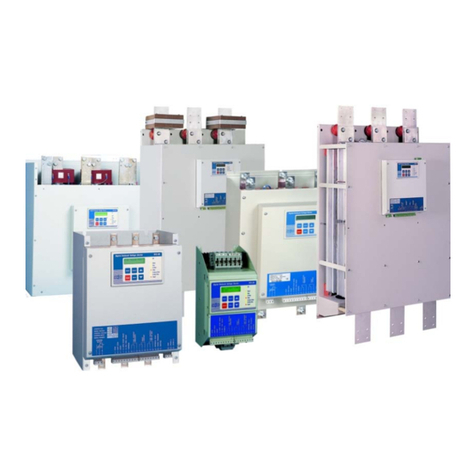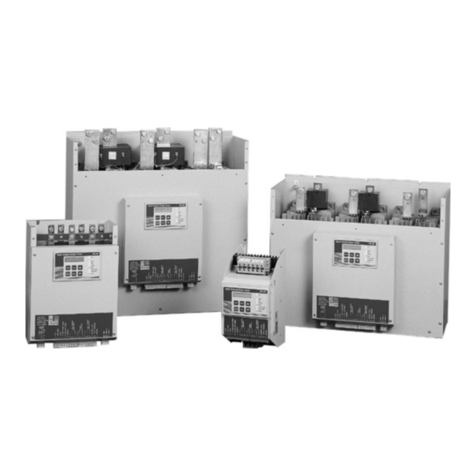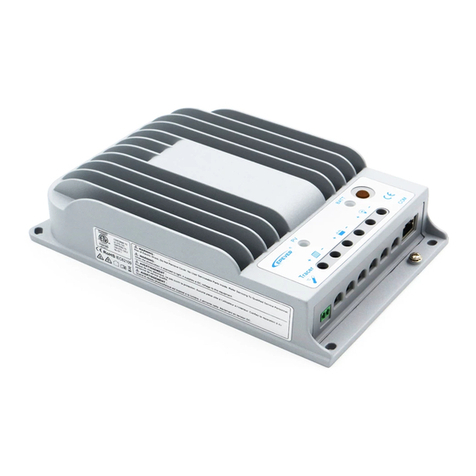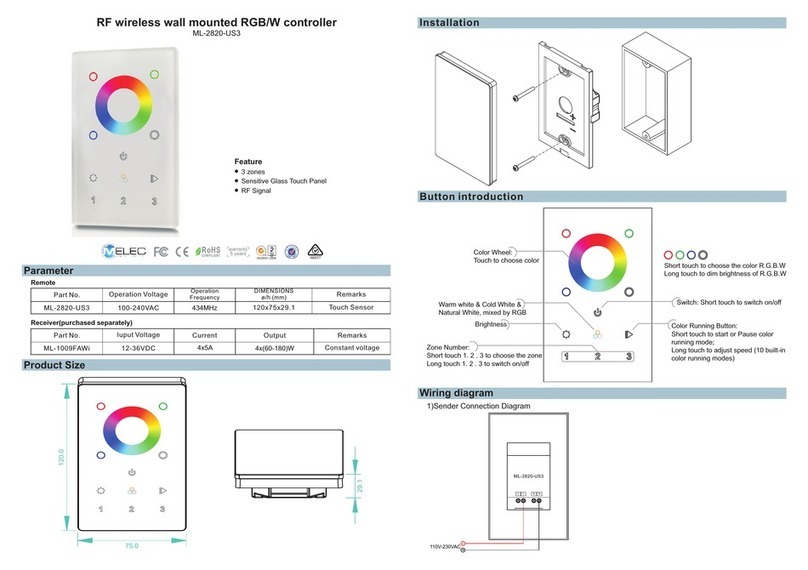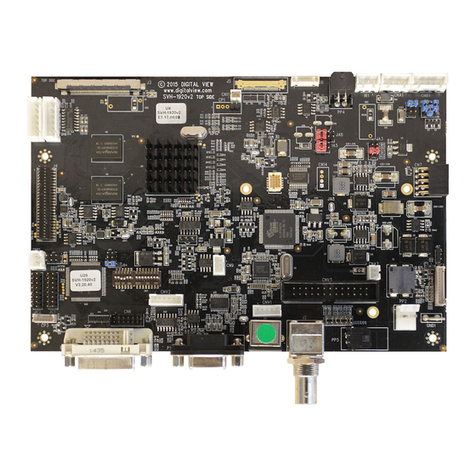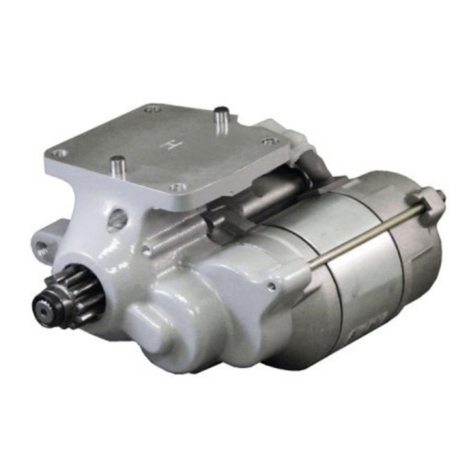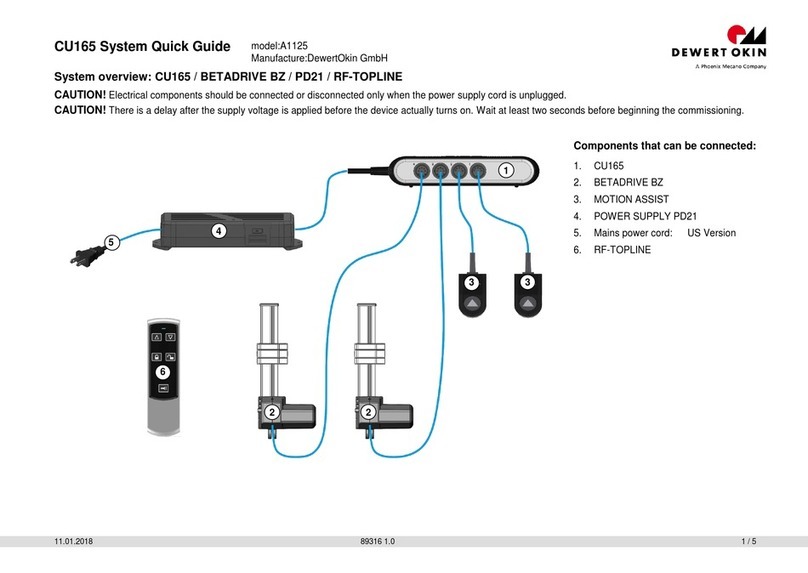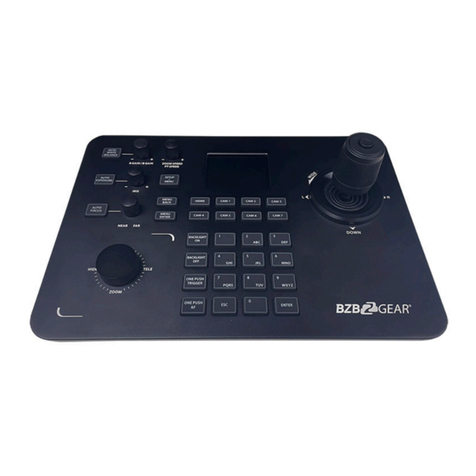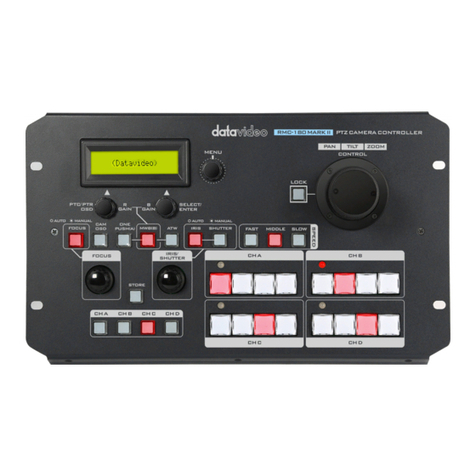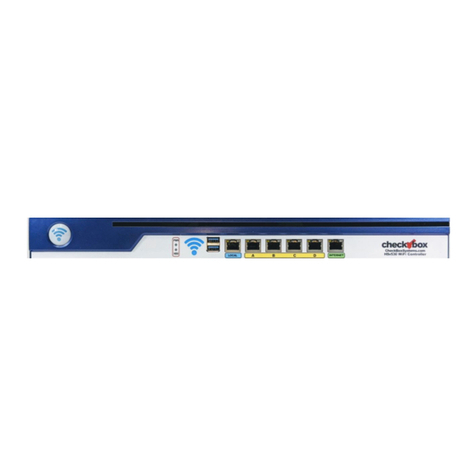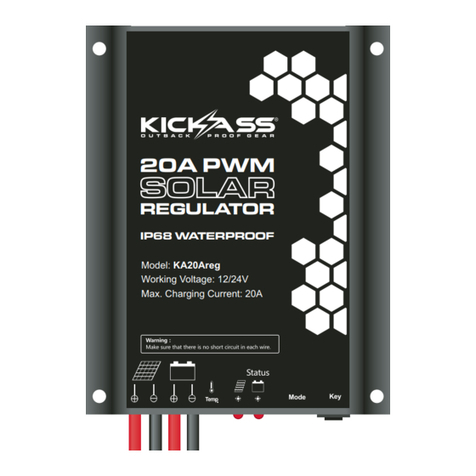Solcon RVS-BX Series User manual

R
RV
VS
S-
-B
BX
X
C
Co
om
mp
pa
ac
ct
t
S
So
of
ft
t
S
St
ta
ar
rt
te
er
r
8
8-
-8
85
5A
A,
,
2
22
20
0-
-6
60
00
0V
V
I
In
ns
st
tr
ru
uc
ct
ti
io
on
n
M
Ma
an
nu
ua
al
l
Ver. 1.4.2002

Table of Contents
Page Subject
3 Starter Selection
4 Installation Notes
5 Wiring
6 Starter Settings
6 Start-up Procedure
7 Dimensions
8 Technical Specification
Safety
• Read this manual carefully before operating the equipment and follow its instructions.
• Installation, operation and maintenance should be in strict accordance with this manual,
national codes and good practice. Installation or operation not performed in strict
accordance with these instructions will void manufacturer's warranty.
• Disconnect all power inputs before servicing the soft-starter and/or the motor.
• After installation, check and verify that no parts (bolts, washers, etc) have fallen into the
starter.
Attention
1. This product was designed and tested for compliance with IEC947-4-2 for class A equipment.
2. The RVS-BX is designed to meet UL, cUL requirements.
3. Use of the product in domestic environments may cause radio interference, in which case the user may
be required to employ additional mitigation methods.
4. Utilization category is AC-53a or AC53b. Form1.
5. For further information see Technical Specification.
Warnings
• Internal components and P.C.B's are at Mains potential when the RVS-BX is connected to
mains. This voltage is extremely dangerous and may cause death or severe injury if
contacted.
• When RVS-BX is connected to Mains, even if start signal has not been issued, full voltage
may appear on motor's terminals. Therefore, for isolation purposes it is required to connect
an isolating device (C/B, switch, line contactor, etc) upstream to the RVS-BX.
• Starter must be properly grounded to ensure correct operation and safety.
•Check that Power Factor capacitors are not connected to the output side of the soft starter
The company reserves the right to make any improvements or modifications to its products without prior notice.
2

Starter Selection
The RVS-BX is a Basic Analogue soft starter which
incorporates six thyristors to start a three phase squirrel
cage induction motor. By supplying a slowly
increasing voltage, it provides soft start and smooth
stepless acceleration, while drawing the minimum
current necessary to start the motor.
A Soft Stop feature can be enabled when the Ramp-
Down potentiometer is adjusted. When used, upon stop
signal (open contact terminals 1 and 2), motor's voltage
is slowly reduced to zero.
Soft-Start Characteristics
M%
Torque
I%U%
CurrentVoltage
100
100
400
10
50
100
Soft-Stop Characteristics
Used for controlled
deceleration of pumps and high
friction loads.
RVS-BX ratings and Frame sizes
Max. Motor
FLA (Amp)
Starter Type
FLC(Amp.)
Frame
Size
8 RVS-BX 8
17 RVS-BX 17 B1
31 RVS-BX 31
44 RVS-BX 44
58 RVS-BX 58
B2
72 RVS-BX 72 B3
85 RVS-BX 85 B4
Dimensions (mm) & Weights (Kg)
Size Width Height Depth Weights (Kg)
B1 65 190 114 1.15
B2 120 207 102.5 1.3
B3 129 275 181.5 7.5
B4 129 380 181.5 10.9
The starter should be selected in accordance with the
following criteria:
1. Motor Current & Starting Conditions
Select the soft-starter according to motor's Full Load
Ampere (FLA) - as indicated on its nameplate (even if
the motor will not be fully loaded).
The RVS-BX is designed to operate under the
following maximum conditions:
Amb. Temp. I start Acc. Time
300% In 30 Sec
350% In 20 Sec
40° C
400% In 5 Sec
Max. Starts per Hour : 4 starts per hour at maximum
ratings. Up to 10 starts per hour at light load
applications.
For higher ratings and /or frequent starts - consult
factory with the following information :
• Ambient temperature.
• Actual stating current.
• Actual starting time.
• Time interval between starts
• Load characteristics
U%
Voltage
10
50
100
Notes: For very frequent starts (inching applications)
the inching current should be considered as the
Full Load Current (FLC) – consult factory.
2. Mains Voltage
Each starter is factory set for one of the following
levels according to the Ordering Information.
Voltage Tolerance
220- 240 V * +10 -15 %
380 - 415 V +10 -15 %
440 V +10 -15 %
460 - 500 V * +10 -15 %
575 - 600 V +10 -15 %
Frequency: 50 / 60 Hz.
* See drawing below for on site voltage modification
Starter’s rated 460-500VAC can be field modified for
system voltage of 220-240VAC, by placing the
internal jumper J3 as shown below. (View when top
cover is removed)
3
123123
460 to 500V220 to 240V
L1L2L3
123
J3

Installation Notes
1. Prior to Installation
Check that Motor's Full Load Ampere (FLA) is lower
than or equal to starters Full Load Current (FLC) and
that Mains voltage is as indicated on the front panel.
2. Mounting
X 3
RVS-BX
M
• The soft starter must be mounted vertically. Allow
sufficient space above and below the starter for
suitable airflow.
• It is recommended to mount the starter directly on
the rear metal plate of the switchgear for better
heat dissipation.
• Do not mount the starter near heat sources.
• Protect the starter from dust and corrosive
atmospheres.
3. Temperature Range and Heat Dissipation
The starter is rated to operate over a temperature range
of –10ºC (14ºF) to +40ºC (104ºF).
Relative non-condensed humidity inside the enclosure
should not exceed 93%.
As the thyristors are bypassed after the end of
acceleration, the heat dissipation during continuous
operation is Approx. 0.4 x In (in watts).
Example: When motor's current is 30 Amp, heat
dissipation will be approx. 12 watts.
Internal enclosure heating can be reduced through the
use of additional ventilation.
4. Transient Protection
Voltage spikes can cause malfunction of the starter and
damage the SCRs. When expected, use suitable
protection such as Metal Oxide Varistors (consult
factory for further details).
5. Power Connections
Line voltage must be connected to terminals L1, L2
and L3. Motor must be connected to terminals U, V
and W. Do not interchange line and load terminals as
damage could occur to the equipment.
6. Overload and Short Circuit Protection
The RVS-BX should be protected against a short
circuit by Thyristor Protection fuses.
The recommended I2 t values are:
RVS-BX type I²t
RVS-BX 8 400
RVS-BX 17 2000
RVS-BX 31 3000
RVS-BX 44 6000
RVS-BX 58 12000
RVS-BX 72 18000
RVS-BX 85 ??????
Caution
Power factor correction capacitors must not be
installed on starter's Load side. When required,
Install capacitors on the Line side.
Warning
When Mains voltage is connected to the starter,
even if start signal has not been initiated, full
voltage may appear on the starter’s load
terminals. Therefore, for isolation purposes it is
required to connect an isolating device (C/B,
switch, line contactor, etc) upstream to the
RVS-BX (on the Line Side).
Built-in Bypass
The RVS-BX incorporates
internal bypass relays
allowing current flow
through the thyristors only
during starting process. At
the end of the starting
process the built-in relays
bypass the thyristors and
carry the current to the
Motor.
Warning
Do not connect any voltage to the control terminals 1
and 2. Upon stop signal, or in case
of fault, all three bypass
relays will open and stop the motor.
When Ramp-Down potentiometer is set to allow soft-
Stop process, upon stop command, the bypass relays
will open immediately and the current will flow
through the thyristors. The voltage will then be
reduced slowly and smoothly to zero.
4

Wiring
Block and Connection Diagram
NOTE: The RVS-BX incorporates an internal control
voltage transformer connected to phases L1&L3, in
case of phase loss of L1 or L3 the starter will stop the
motor.
Stop / Start......................................... Terminals 1 - 2
By voltage free contact (Dry contact)
Close: Start command.
1
L2
L3
L
RVS -BX
Reduced Voltage Starter
T1/U T2/V T3/W
End of
Ac ce l e ra ti o n
Start
Stop
1234
On Initial Voltage
10% 50%
Ramp
Up
230Sec.
Down
30 Sec.0.2
Open : Stop command.
Warning
Do not apply voltage to terminals 1 - 2.
End of Acceleration (E.O.A) .......... Terminals 3 - 4
Voltage free, N.O., 8A / 250VAC, 2000VA max.,
The contact closes after the time adjusted on the
"Ramp-Up" potentiometer. The contact returns to its
original position on stop signal, on fault condition,
upon voltage outage and at the end of Soft Stop.
Use of E.O.A. Contact
This contact can be used for applications such as:
• Activating a valve after a compressor has reached
full speed
• Loading a conveyor after the motor has reached
full speed.
Warning
Start/Stop with a maintained contact !
When the line contactor is operated by a
maintained contact, in case of Mains failure, the
motor will be automatically restarted upon
voltage restoration.
When resetting after a fault with the Reset
button, the motor will restart upon fault reset.
It is therefore recommended not to connect the
fault relay to the line contactor.
Connection Diagram
U
L1
V
L2
W
L3
MOTOR
Start/
E.O.A
Bypass
1234
Stop
M
1/L1
RVS-BX
W1V1U1
T1/U
T2/V
T3/W
L1
L2
L3
Neutral
R1A
R1C
1 2
Start / Stop
End Of
Acceleration
Ground
3/L2
5/L3
43
I>
I>I>
Q1
x 3
S1
5

Starter Settings and Startup Procedure
Front Panel Layout
10% 50%
Initial Voltage
Up
20 Sec.
Down
°°
°
°°
°°
°° °
°°
°
°°
1
1
20 Sec.
Ramp
Initial Voltage
Determines the initial voltage to the
motor (The torque is directly
proportional to the square of the
voltage).
Range : 10-50% of nominal voltage.
This adjustment also determines the
inrush current and mechanical shock.
Too high of a setting may cause high initial mechanical
shock and high inrush current (even if Current Limit is set
low, as the Initial Voltage setting over-rides the Current
Limit setting).
Too low of a setting may result in prolonged time until
motor starts revolving. The motor should start revolving
immediately after Start signal.
Ramp-up Time
Determines motor's voltage ramp-up
time from initial to full voltage.
Range: 1-20 sec.
It is recommended to set Ramp-Up
Time to the minimum acceptable
value (approx. 5 Sec).
Note: When motor reaches full speed before voltage
reaches nominal, Ramp-Up Time adjustment is overridden,
causing voltage to quickly ramp up to nominal.
Ramp-Down time (Soft-stop)
Used to control deceleration of high friction
loads. When Ramp-Down potentiometer is set,
upon stop signal the starter output voltage is
gradually ramped down.
Range: 1-20 sec. When "Ramp-down Time" is
set to minimum, the E.O.A relay will change
position and the motor will stop immediately.
Startup Procedure
1. Set front panel potentiometers as follows:
• Initial voltage to 30%.
• Ramp Up Time to 5 sec.
2. Install a clamp-type ammeter on one of the lines.
3. Connect mains voltage to RVS-BX line terminals. The
ON LED will light up
4. Connect control terminals 1-2. The ammeter will show
current flow. If motor starts rotating and accelerates to
full speed proceed to Para. 6.
If not, increase Starting voltage setting until motor
starts rotating shortly after start signal.
In case the initial inrush current and mechanical shock
are too high, decrease Starting Torque setting and
proceed to Para.6.
U%
100%
5. Open contact between terminals 1 and 2 to soft Stop
and wait until motor stops.
50%
6. Close contact between terminals 1 and 2 to Start again
and see that acceleration process to full speed is as
required.
10%
230 Sec
7. If acceleration time is too short, increase ramp up time
setting.
Note:
The "ON" LED on the front panel will light up only upon
receipt of main voltage at terminals L1, L2 and L3.
Example of Starting Curve
Light loads such as
Pumps, Fans, Etc.
U%
100%
5t
I%
600%
100%
50%
30%
10%
400%
300%
t
U%
100%
The voltage will quickly increase to the Starting Torque
value and then gradually ramp-up to nominal voltage.
Simultaneously, the current will smoothly increase to reach
peak current value, before smoothly decreasing to the
operating current. The motor will steplessly accelerate to
full speed.
120 Sec
Note:
In general the starting time is less than the ramp up time
and depends on the load characteristics and not on the ramp
up time potentiometer.
6

Dimensions & Weights
190
S
Power & Control Connections
Starter Type
In Ampere
Size Power
Connections
Control
Connections
RVS-BX 8
RVS-BX 17
B1
RVS-BX 31
RVS-BX 44
RVS-BX 58
B2
Terminals
16 mm2
RVS-BX 72 B3 Bus-Bars 15mm x 3mm
RVS-BX 85 B4 Bus-Bars 20mm x 4mm
Terminals
1.5 mm2
B1
LLL
123
RVS - BX
Reduced Voltage Starter
UVW
=1.5mm
2
S=16mm
2
93
75
7
102.5
197
207
90
120
RVS-BX
Reduced Voltage Starter
VU W
L
1
L3
2L
S=1.5mm
2
S=6mm
2
39
98
114
6
42
180
Reduced Voltage Starter
RVS - BX
S=2.5mm2
92 4
181.5
92 4
40
40
172
7
275
16
8.5
255
108
129
B3
65
B2
Reduced Voltage Starter
RVS - BX
S=2.5mm2
92 4
181.5
92 4
40
40
172
7
380
20
8.5
360
108
129
B4

Technical Specification
Environment
Supply voltage Three phase, line to line,
220 – 240 Vac +10% -15% *
380 – 415 Vac +10% -15%
460 – 500 Vac +10% -15% *
575 – 600 Vac +10% -15%
* 460 – 500 Vac is applicable for 220 – 240 Vac
by change position of an internal jumper – J3. As
shown in page 3.
Frequency 50 / 60 Hz
Load Three-Phase, Three-Wire, Squirrel Cage
Induction Motor
Degree of protection IP 20
Altitude 1000 M above sea level Consult factory for derating above 1000 Meters
Adjustments
Starting Torque (Initial Voltage) 10-50 % of full voltage
Ramp Up Time (soft start) 1 - 20 sec.
Ramp Down Time (Soft Stop) 0.1 - 20 sec.
Control
Indication light(LED) ON - Green Lights when three phases are connected to the
RVS-BX.
Temperatures
Operating -10° to 40°C
Storage -20° to 70°C
Relative humidity 93 % - non condensed
EMC
Immunity to radioelectric interference EN 1000-4-3 level 3 Conforming to EN 60947-4-2
Electrostatic discharge EN 1000-4-2 level 3 Conforming to EN 60947-4-2
Immunity to electrical transients EN 1000-4-4 level 4 Conforming to EN 60947-4-2
Shock waves of voltage / current EN 1000-4-5 level 3 Conforming to EN 60947-4-2
Radiated and conducted emissions EN 1000-4-6 level 3
Radio frequency emissions According to EN 55011 class A Conforming to EN 60947-4-2
Mechanical
Shock resistance 8 gn Conforming to EN 60947-4-2
Vibration resistance 2 gn Conforming to EN 60947-4-2
Output relay
End of Acceleration Contact N.O.
Rated operating current 5 A, 250 V - Size B1
8 A, 250 V – Size B2-B4
N:\eli\Eli's 95_bup\Solcon-CD for Distributors 05-03-2002\Instruction Manuals\RVS-BX Instruction Manual1.doc
This manual suits for next models
7
Table of contents
Other Solcon Controllers manuals
Popular Controllers manuals by other brands
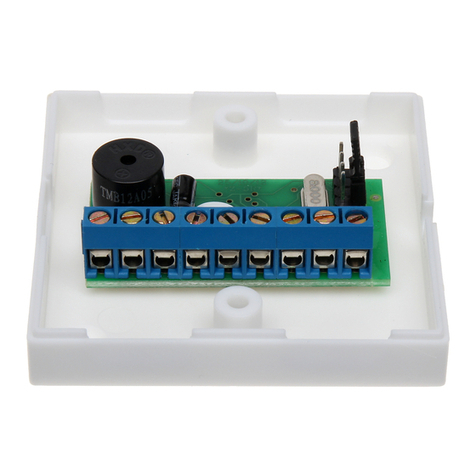
Iron logic
Iron logic Z-5R Relay Wiegand user manual
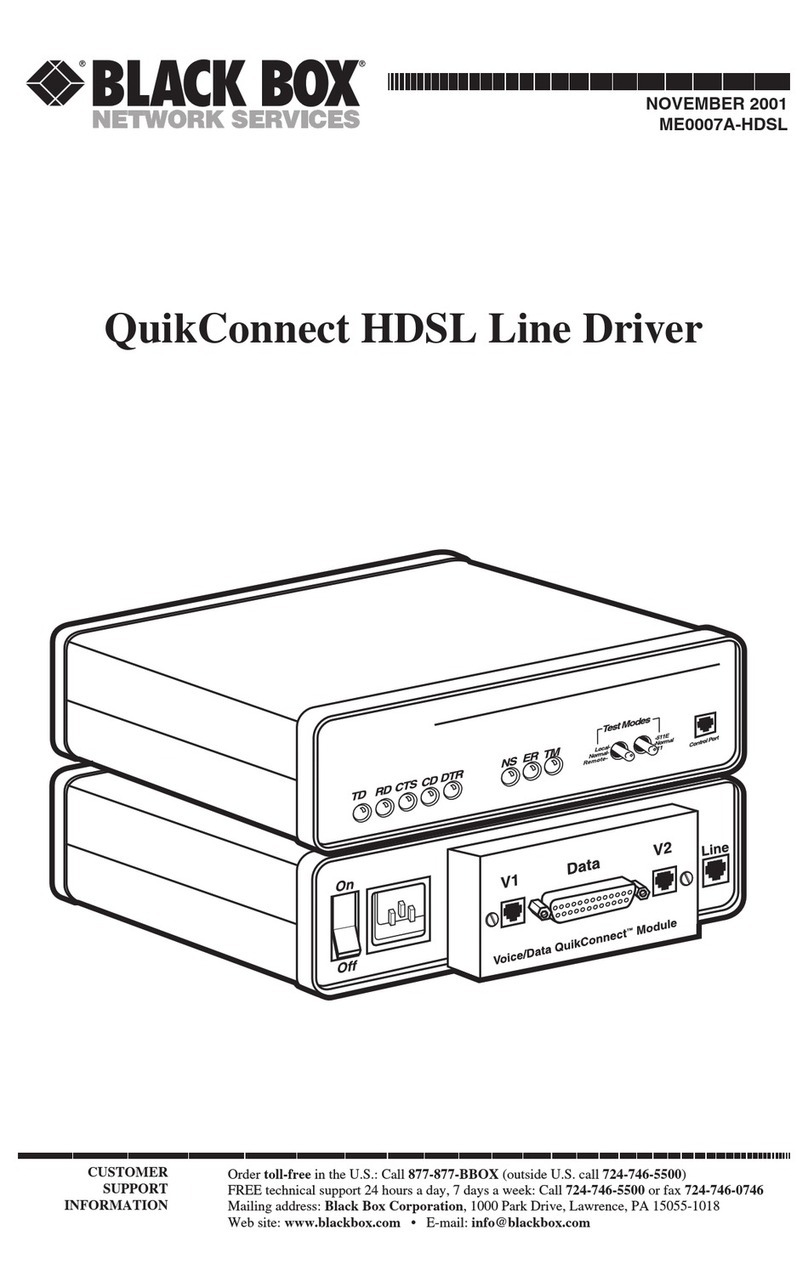
Black Box
Black Box QuikConnect ME0007A-HDSL manual
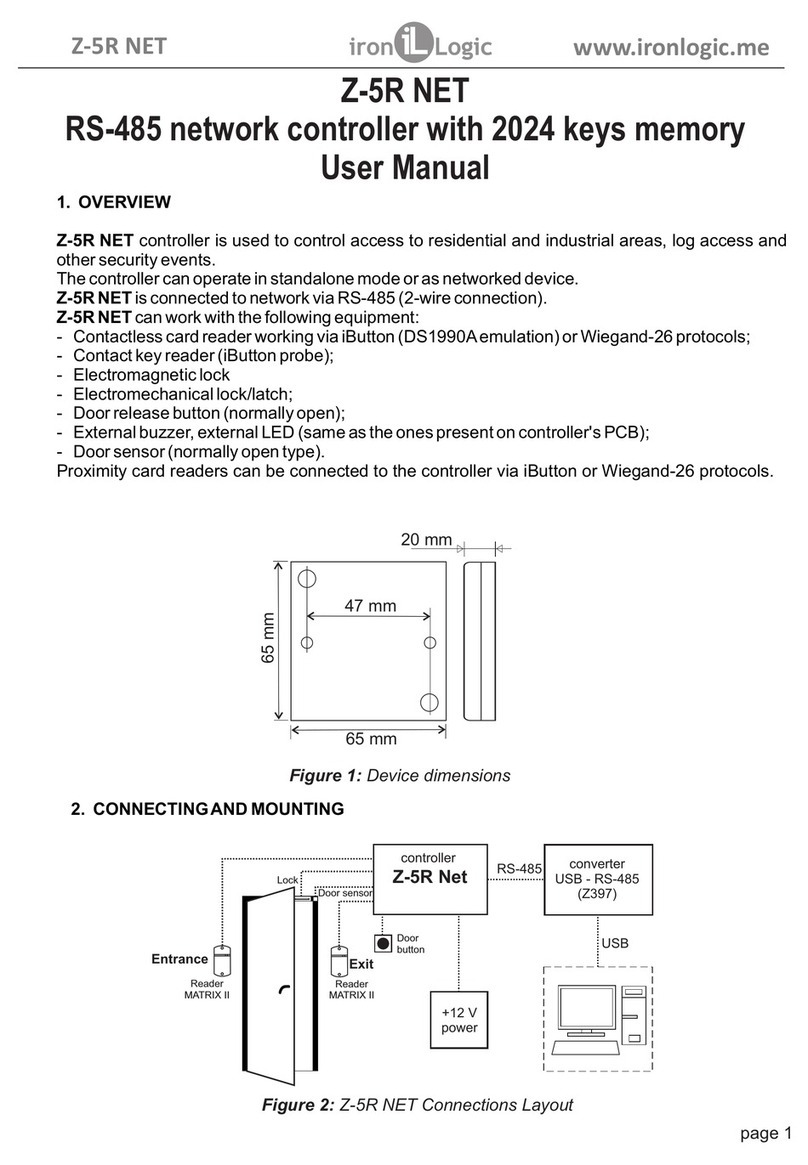
Iron logic
Iron logic Z-5R NET user manual
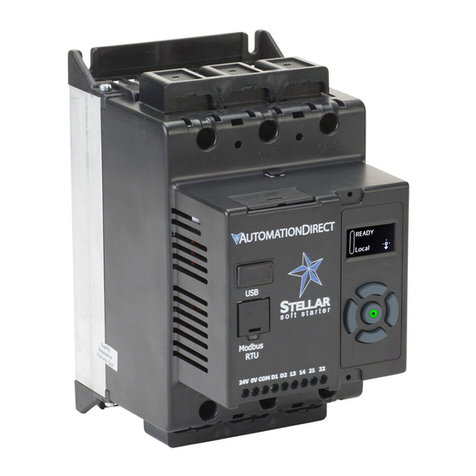
AutomationDirect
AutomationDirect Stellar SR35 Series quick start guide
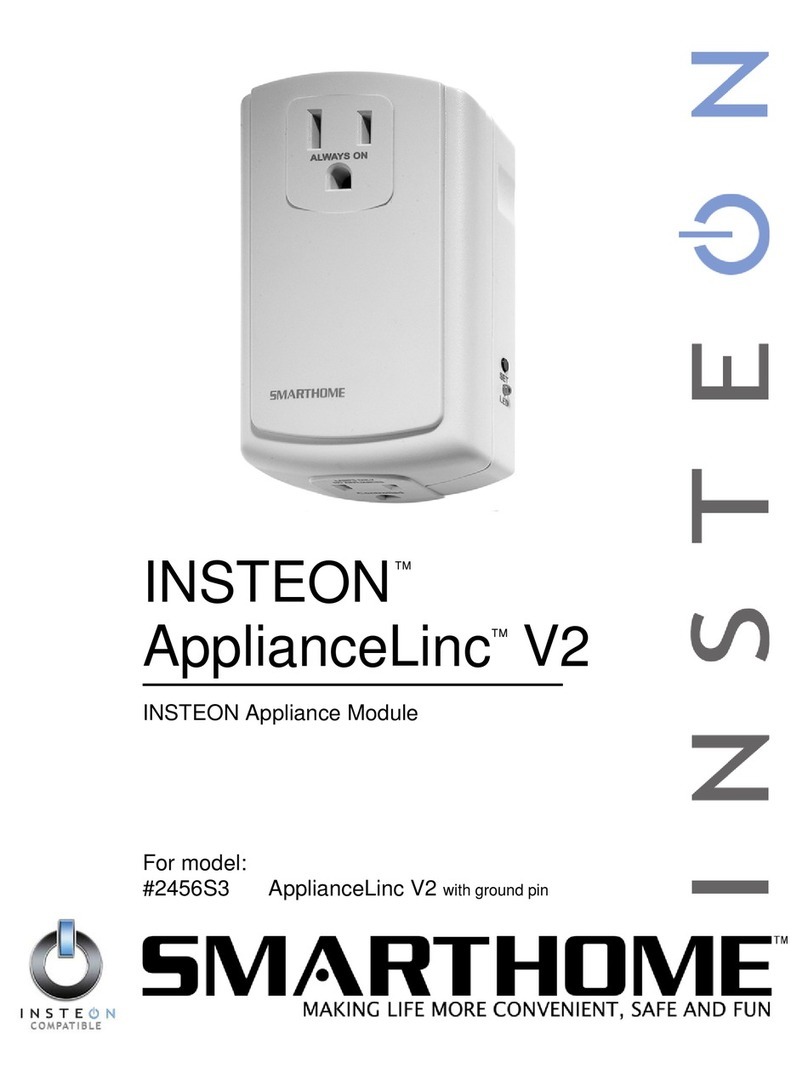
smart home
smart home ApplianceLinc V2 user guide
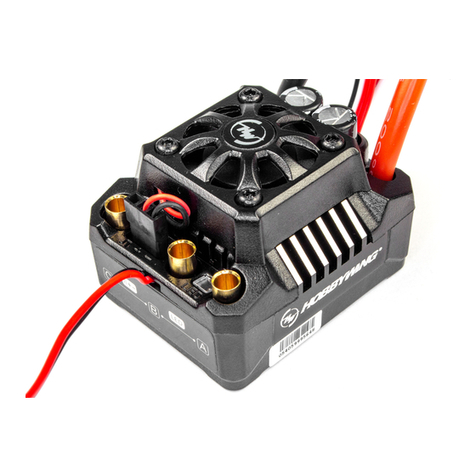
Hobby-Wing
Hobby-Wing EZRUN MAX10 SCT user manual
